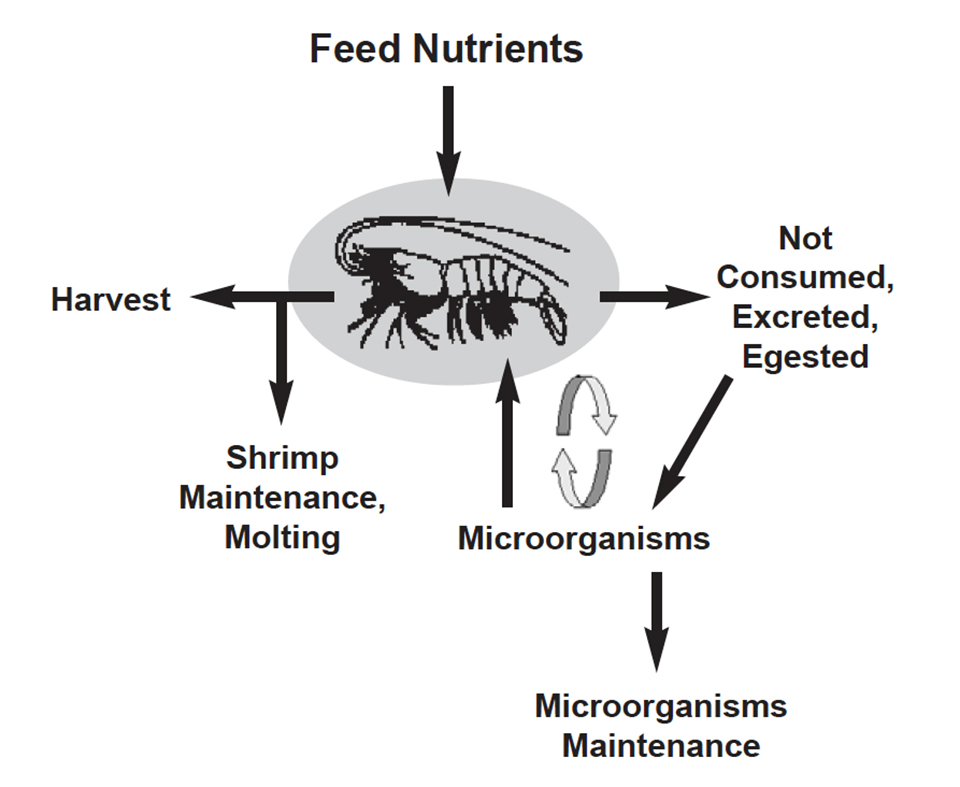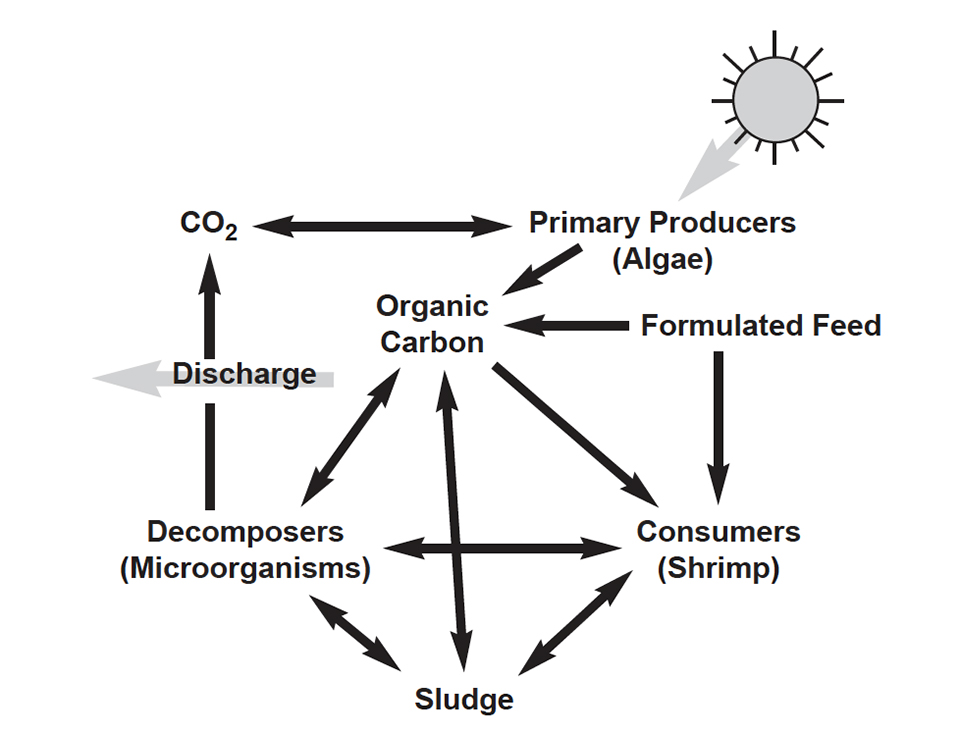Reduce feed costs by recycling waste through the microbial community
Shrimp are the most commercially important aquaculture animals that utilize a significant amount of microorganisms in their diet (Fig. 1) and, thus, deserve special attention. Studies have shown that feed utilization by shrimp is quite poor. Only 17 percent of the nutrients in feeds of intensive shrimp aquaculture end up in shrimp tissue. About 15 percent of the feed is not consumed by the shrimp, and 20 percent is egested. The largest portion, about 48 percent, is lost due to molting, maintenance energy, and release by excretion. Thus, the majority of the energy in the feed is lost. With proper management, unutilized feed can be used as a resource rather than becoming a waste, saving money for the farmer while protecting the environment.
Wasted feed is the major source of pollution that leaves the aquaculture facility. This fact has a direct impact on the sustainability of the aquaculture operation. Microorganisms, including bacteria and algae, can utilize wasted feed with high efficiency. When they, in turn, become feed for the cultured animals, the overall utilization of feed is increased, and the feed conversion ratio becomes more favorable. Thus, with good feed management, the microorganisms that are present in aquaculture ponds and serve as natural food for the shrimp may not just contribute to the shrimp’s diet, but may actually constitute a large portion of it, replacing part of the costly formulated feed.
The aquaculture environment and microorganisms

Microorganisms thrive in the aquaculture environment, since there is plenty of food for their growth and reproduction. They have great metabolic versatility and can utilize compounds that contain carbon, nitrogen, phosphorus or sulfur, which are widely available in fish and shellfish facilities. Microorganisms are generally more efficient in utilizing these compounds than larger organisms, such as fish and shellfish. Moreover, they metabolize a wider range of compounds than fish and shellfish, and thus utilize parts of the feed that these animals cannot digest. In this way, microorganisms can turn simple and complex food sources into proteins and vitamins.
Thus, microorganisms in an aquaculture setting may utilize uneaten feed, animal excretion products (e.g., feces, ammonia), and decaying material. In some cases, however, microorganisms may compete with cultured animals for the same nutrients. Generally, microorganisms in the water column and in the sediment of aquaculture facilities control the fate of many organic and inorganic compounds via aerobic or anaerobic metabolic processes. Aquaculture microbial aerobic and anaerobic processes are described in more detail in the article “Aquaculture and the Microbial World” in the February 2000 issue of the Advocate.
The microorganisms in the aquaculture environment are, in turn, natural sources of food for many aquatic animals, such as shrimp, clams, conchs, sea cucumbers and some fish. These animals, which are grazers or filter feeders, rely on the microbial food either as a sole source of nutrients or as a complimentary food source. Shrimp have the ability to either eat microorganisms directly, or to eat the predators of the microorganisms like protozoa and small invertebrate animals. The protein content of microorganisms is similar to that found in formulated feeds. In addition, microorganisms contain vitamins that can reduce or even eliminate the need for supplemental vitamins in formulated feed. As a result, diets which are less nutritionally complete and lower in protein content can be used to feed shrimp if microorganisms are permitted to recycle the waste from this inexpensive feed into a natural, high quality food for the shrimp.
Sources of nutrients
The nutrients in shrimp ponds come from two main sources: formulated feed and algal photosynthesis. A large portion of feed and dead algal cells is not immediately consumed by shrimp. In conventional ponds, much of the organic matter either sinks to the bottom to form a layer of sludge or flushes out of the pond through water exchange (Fig. 2). Sludge is poorly utilized by shrimp, and generally has a deleterious effect on aquatic animals. The sludge environment lacks oxygen. Anaerobic microbial processes in the sludge may result in the production of toxic compounds. For example, sulfur reduction in the sludge may result in the formation of hydrogen sulfide, which is highly toxic to most biological forms. Better feed utilization by the shrimp will result in less sludge.

In intensive, low-water-exchange ponds, aeration and mixing are crucial to continually resuspend organic particles, avoid formation of sludge, and maintain an active aerobic microbial community. Under such conditions, a relatively small amount of water leaves the pond, providing an opportunity for nutrients to accumulate and for the microbial community to reach a sufficient density. Some of these microorganisms are, in turn, eaten by shrimp.
The exact contribution of microbial food to the nutrition of shrimp is determined by several factors. For example, high amounts of formulated feed will decrease the need of the shrimp to forage for natural food. Frequency of feeding will also affect the amount of natural food that the shrimp may consume. Availability of the microorganisms to the shrimp is another major factor that determines how much of the shrimp’s diet is composed of microorganisms.
Under appropriate conditions, over half of the shrimp’s diet consists of microbial floc. Maintaining a microbial floc that significantly supports the shrimp’s diet is not a simple task. However, if successful, its payoff will be significant, as it will lower the use of formulated feed, lower the amount of accumulated sludge, and lower environmental impact by having a smaller amount of waste discharged by the farm.
Optimizing utilization of natural production
Several researchers, including us, are working on the optimization of natural food utilization by shrimp. Promising directions of such research include:
- The adjustment of carbon-to-nitrogen ratio in the pond, where excess nitrogen can be rapidly removed by the addition of carbon that is readily eaten by bacteria (e.g., sugar, molasses).
- A single inoculation with beneficial microorganism(s) able to survive and multiply in the pond’s environment.
- The addition of solid support for increased microbial adhesion, and
- Polyculturing the shrimp with highly nutritious algae and artemia in in-pond segmented and secluded areas.
In addition, polyculturing with animals that thrive on suspended microbial floc, such as clams, will positively shift the overall energy and nutrition utilization in shrimp aquaculture. Many questions are still unanswered, but the recognition of the important role of microorganisms in shrimp nutrition drives more researchers and farmers towards developing microbial management techniques of the shrimp pond, where a portion of the formulated feed is replaced by natural food. Microbial management of the shrimp pond will probably require two feeding regimes – simple feed for the microorganisms and lower amounts of formulated feed for the shrimp.
Conclusions
Intensive, low-water-exchange systems offer opportunities for shrimp farmers to reduce feed costs by recycling waste through the microbial community. This also reduces pollution in the outlet of the farm, which improves the sustainability, extends the life, and increases the value of the farm, and improves compliance with existing or future government regulations.
(Editor’s Note: This article was originally published in the April 2000 print edition of the Global Aquaculture Advocate.)
Now that you've finished reading the article ...
… we hope you’ll consider supporting our mission to document the evolution of the global aquaculture industry and share our vast network of contributors’ expansive knowledge every week.
By becoming a Global Seafood Alliance member, you’re ensuring that all of the pre-competitive work we do through member benefits, resources and events can continue. Individual membership costs just $50 a year. GSA individual and corporate members receive complimentary access to a series of GOAL virtual events beginning in April. Join now.
Not a GSA member? Join us.
Authors
-
Dr. Ami Horowitz
UPAH Tech, Inc.
Aquaculture and Environmental Microbiology
3666 Stoer Rd.
Shaker Heights, Ohio 44122 USA -
Dr. Sarah Horowitz
UPAH Tech, Inc.
Aquaculture and Environmental Microbiology
3666 Stoer Rd.
Shaker Heights, Ohio 44122 USA
Tagged With
Related Posts

Intelligence
All about Listeria
The pathogenic bacterium Listeria monocytogenes is present in the environment and easily transferred to food and food contact surfaces.

Aquafeeds
Amino acid requirements in developing marine fish
Most marine fish have pelagic eggs with large pools of free amino acids of fairly constant proportion regardless of species. The amino acids provide energy for metabolism and are an important nutritional asset for growing embryos.

Health & Welfare
Ammonia toxicity degrades animal health, growth
Ammonia nitrogen occurs in aquaculture systems as a waste product of protein metabolism by aquatic animals and degradation of organic matter, or in nitrogen fertilizers. Exposure can reduce growth and increase susceptibility to diseases in aquatic species.

Responsibility
Aquaculture and the microbial world
Microorganisms reside in the sediment and other substrates, and in the water of aquaculture facilities, as well as in and on the cultured animals.


